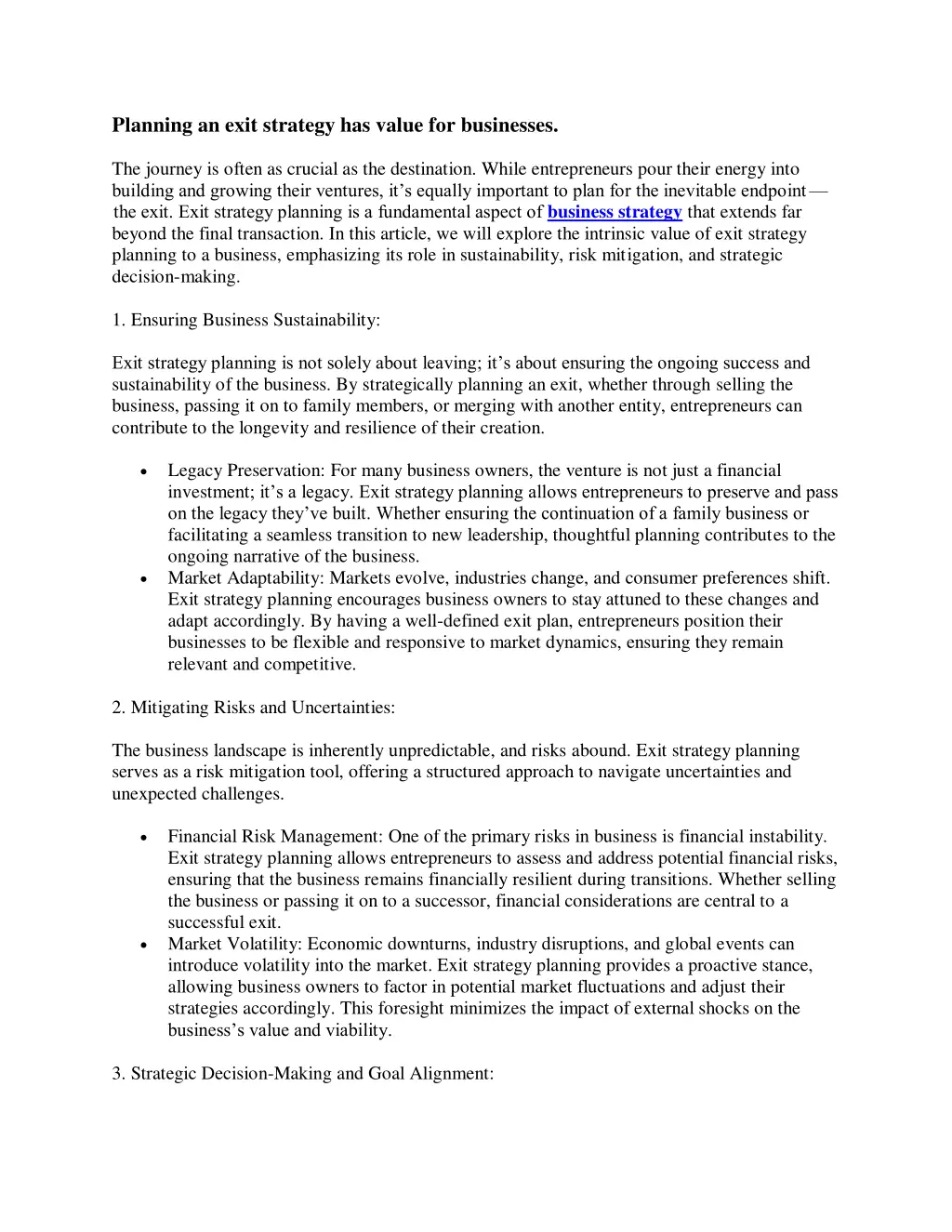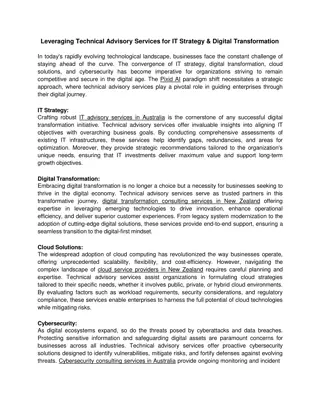
Planning an exit strategy has value for businesses.
The journey is often as crucial as the destination. While entrepreneurs pour their energy into building and growing their ventures, it's equally important to plan for the inevitable endpointu200a-u200athe exit. Exit strategy planning is a fundamental aspect of business strategy that extends far beyond the final transaction. In this article, we will explore the intrinsic value of exit strategy planning to a business, emphasizing its role in sustainability, risk mitigation, and strategic decision-making.
Download Presentation

Please find below an Image/Link to download the presentation.
The content on the website is provided AS IS for your information and personal use only. It may not be sold, licensed, or shared on other websites without obtaining consent from the author. If you encounter any issues during the download, it is possible that the publisher has removed the file from their server.
You are allowed to download the files provided on this website for personal or commercial use, subject to the condition that they are used lawfully. All files are the property of their respective owners.
The content on the website is provided AS IS for your information and personal use only. It may not be sold, licensed, or shared on other websites without obtaining consent from the author.
E N D
Presentation Transcript
Planning an exit strategy has value for businesses. The journey is often as crucial as the destination. While entrepreneurs pour their energy into building and growing their ventures, it s equally important to plan for the inevitable endpoint the exit. Exit strategy planning is a fundamental aspect of business strategy that extends far beyond the final transaction. In this article, we will explore the intrinsic value of exit strategy planning to a business, emphasizing its role in sustainability, risk mitigation, and strategic decision-making. 1. Ensuring Business Sustainability: Exit strategy planning is not solely about leaving; it s about ensuring the ongoing success and sustainability of the business. By strategically planning an exit, whether through selling the business, passing it on to family members, or merging with another entity, entrepreneurs can contribute to the longevity and resilience of their creation. Legacy Preservation: For many business owners, the venture is not just a financial investment; it s a legacy. Exit strategy planning allows entrepreneurs to preserve and pass on the legacy they ve built. Whether ensuring the continuation of a family business or facilitating a seamless transition to new leadership, thoughtful planning contributes to the ongoing narrative of the business. Market Adaptability: Markets evolve, industries change, and consumer preferences shift. Exit strategy planning encourages business owners to stay attuned to these changes and adapt accordingly. By having a well-defined exit plan, entrepreneurs position their businesses to be flexible and responsive to market dynamics, ensuring they remain relevant and competitive. 2. Mitigating Risks and Uncertainties: The business landscape is inherently unpredictable, and risks abound. Exit strategy planning serves as a risk mitigation tool, offering a structured approach to navigate uncertainties and unexpected challenges. Financial Risk Management: One of the primary risks in business is financial instability. Exit strategy planning allows entrepreneurs to assess and address potential financial risks, ensuring that the business remains financially resilient during transitions. Whether selling the business or passing it on to a successor, financial considerations are central to a successful exit. Market Volatility: Economic downturns, industry disruptions, and global events can introduce volatility into the market. Exit strategy planning provides a proactive stance, allowing business owners to factor in potential market fluctuations and adjust their strategies accordingly. This foresight minimizes the impact of external shocks on the business s value and viability. 3. Strategic Decision-Making and Goal Alignment:
Exit strategy planning is intertwined with strategic decision-making. It prompts business owners to align their long-term goals with their exit objectives, fostering a cohesive and purposeful approach to business management. Clarity in Decision-Making: Knowing the desired endpoint provides clarity in day-to-day decision-making. Whether expanding operations, diversifying product offerings, or entering new markets, strategic decisions are made with the ultimate exit strategy in mind. This alignment ensures that every action contributes to the overall success of the business and its eventual exit. Alignment with Stakeholder Expectations: Businesses involve various stakeholders employees, investors, partners, and customers. Exit strategy planning enables business owners to align their exit goals with the expectations of these stakeholders. Transparent communication and a shared vision contribute to a harmonious transition, reducing potential disruptions and building trust. 4. Accessing Capital and Investment Opportunities: Exit strategy planning opens doors to various capital and investment opportunities. Whether seeking investors, attracting potential buyers, or exploring mergers and acquisitions, a well- structured exit plan enhances the business s attractiveness to external parties. Investor Confidence: Potential investors are more likely to engage with a business that has a clear and well-thought-out exit strategy. The assurance that the business has a roadmap for growth and a planned exit contributes to investor confidence. This confidence can translate into increased funding opportunities and partnerships. Market Recognition and Valuation: A defined exit strategy enhances a business s market recognition and valuation. Investors and potential buyers are drawn to businesses that demonstrate a strategic approach to their future. A well-planned exit contributes to a positive perception of the business s value and potential return on investment. 5. Facilitating Smooth Transitions: Change is inevitable, and transitions are a natural part of the business lifecycle. Exit strategy planning facilitates smooth transitions, ensuring that the business continues to thrive even in the midst of change. Succession Planning: For businesses passed on to family members or internal teams, exit strategy planning integrates succession planning. This involves identifying and developing future leaders within the organization, creating a seamless transition that preserves institutional knowledge and maintains operational continuity. Employee Retention and Morale: Clear communication about exit plans helps retain valuable employees and maintain morale. When employees are informed and confident in the business s future, they are more likely to remain committed and contribute positively during times of transition. Strategic Departure for Long-Term Success
Exit strategy planning is not an admission of defeat; rather, it is a strategic departure that enhances the overall success and sustainability of a business. By recognizing the intrinsic value of exit strategy planning, entrepreneurs position themselves to navigate uncertainties, mitigate risks, and align their business objectives with long-term goals. Whether looking to pass on a legacy, attract investors, or ensure a smooth transition, the benefits of thoughtful exit planning extend far beyond the final transaction, shaping the narrative of the business for years to come.






















